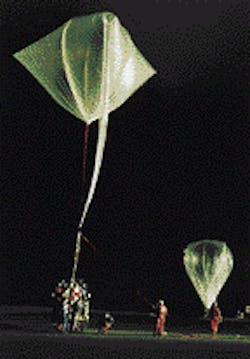AIRBORNE SPECTROSCOPY: System makes science out of moonshine
The moon is proving to be a useful light source for spectroscopy in the stratosphere, a group of French researchers have found. Jean-Baptiste Renard and colleagues at the Centre National de la Recherche Scientifique (CNRS; Orleans, France) have been testing a spectrometer that is carried aloft by balloon and uses moonlight to measure various gas species in the atmosphere.
The instrument, Spectroscopie d'Absorption Lunaire pour l'Observation des Minoritaires Ozone et Nox (SALOMON), flew in a series of test flights in October, January, and February (see photo). The researchers compared its measurements to those from an older instrument, Absorption pare les Minoritaires Ozone et NOx (AMON), that uses a star as a light source. One major problem with the older instrument is that, because starlight is so dim, the device must be large, weighing 500 kg. It takes a big balloon with a lot of gas to carry such an instrument, which puts constraints on the atmospheric conditions under which it can be launched and cuts down on the number of nights when observations can be made.
By contrast, SALOMON weighs only 80 kg and can be launched in a wider range of latitudes and seasonal conditions. It can be used once the moon is 68% full, so flights are possible for at least 10 days a month, as long as moonset or moonrise are not too close to sunset or sunrise. The device also does not require as accurate a pointing system as its predecessor because the angular diameter of the moon is 30 arc min, compared to less than 1 arc sec for a star.
The device includes a spectrometer with the wavelength domain shifted to 350 to 700 nm and a photodiode array of 1024 pixels with a theoretical resolution of 0.34 nm, 2.5 times that of AMON. A 100-µm entrance slit maximizes the light on the detector, and an exposure time of 52 s gives a high signal-to-noise ratio. A 25 x 76-mm plane mirror and a lens that focuses light onto a position sensor track the moon. The moon tracker is connected to the spectrometer via a fiberoptic cable. A pivot equipped with two photodiodes rotates until the flux of moonlight on each diode is identical to orient the setup. The instrument also includes telemetry equipment to feed the data to a ground station.
The device works by recording spectra affected by the atmospheric absorption of light during a moonrise or moonset. The data allow scientists to track levels of nitrous oxides, such as NO2 and NO3, as well as ozone and bromines. The data could lead researchers to a better understanding of atmospheric chemistry. The spectral range of the detector allows them to study absorption features of ozone between 455 and 680 nm, a range of 225 nm compared to 75 nm for AMON. They look at NO2 between 400 and 550 nm, 150 nm compared to 60 nm for AMON. They also look at NO3 between 645 and 680 nm. Because the moon gives more light than a star, researchers can also detect smaller absorption features and therefore get a greater signal-to-noise ratio.
Airborne spectrographs also use the sun as a light source, but the atmosphere behaves differently at night, and scientists want to study both conditions. Researchers are planning a few flights of SALOMON this year and next. It may also be used by European scientists planning a study of the tropics beginning in 2003.
About the Author
Neil Savage
Associate Editor
Neil Savage was an associate editor for Laser Focus World from 1998 through 2000.
